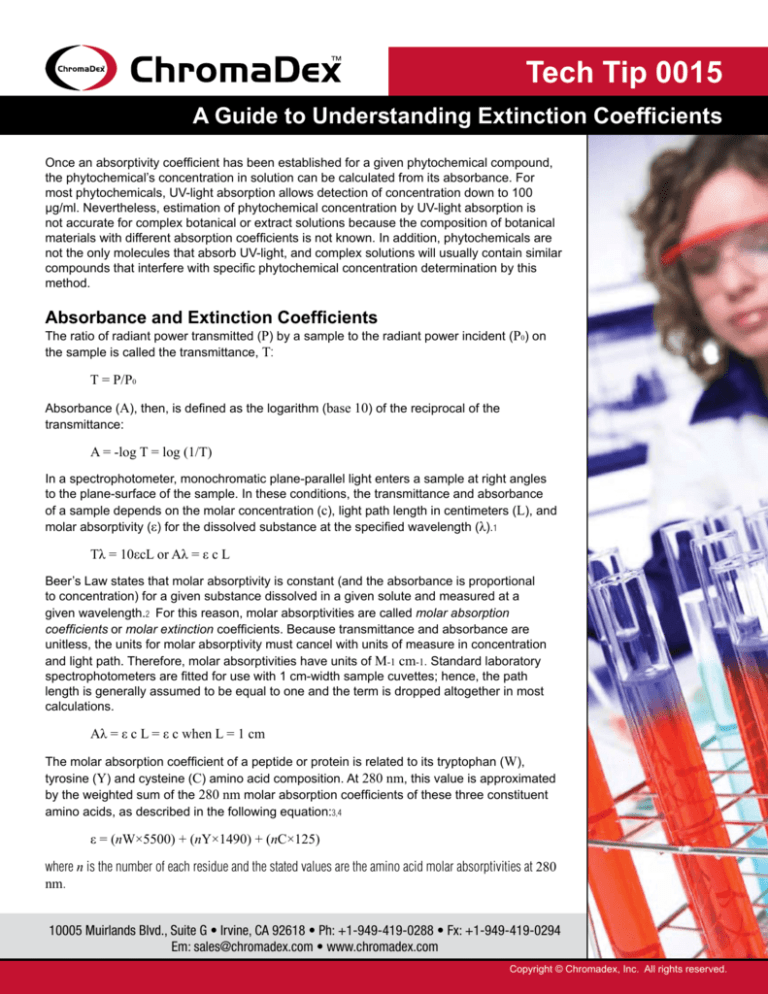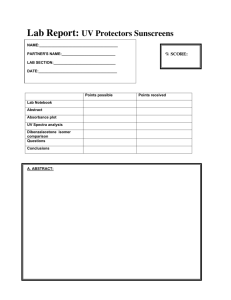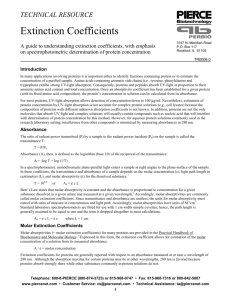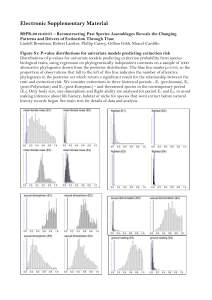
Tech Tip 0015
A Guide to Understanding Extinction Coefficients
Once an absorptivity coefficient has been established for a given phytochemical compound,
the phytochemical’s concentration in solution can be calculated from its absorbance. For
most phytochemicals, UV-light absorption allows detection of concentration down to 100
μg/ml. Nevertheless, estimation of phytochemical concentration by UV-light absorption is
not accurate for complex botanical or extract solutions because the composition of botanical
materials with different absorption coefficients is not known. In addition, phytochemicals are
not the only molecules that absorb UV-light, and complex solutions will usually contain similar
compounds that interfere with specific phytochemical concentration determination by this
method.
Absorbance and Extinction Coefficients
The ratio of radiant power transmitted (P) by a sample to the radiant power incident (P0) on
the sample is called the transmittance, T:
T = P/P0
Absorbance (A), then, is defined as the logarithm (base 10) of the reciprocal of the
transmittance:
A = -log T = log (1/T)
In a spectrophotometer, monochromatic plane-parallel light enters a sample at right angles
to the plane-surface of the sample. In these conditions, the transmittance and absorbance
of a sample depends on the molar concentration (c), light path length in centimeters (L), and
molar absorptivity (ε) for the dissolved substance at the specified wavelength (λ).1
Tλ = 10εcL or Aλ = ε c L
Beer’s Law states that molar absorptivity is constant (and the absorbance is proportional
to concentration) for a given substance dissolved in a given solute and measured at a
given wavelength.2 For this reason, molar absorptivities are called molar absorption
coefficients or molar extinction coefficients. Because transmittance and absorbance are
unitless, the units for molar absorptivity must cancel with units of measure in concentration
and light path. Therefore, molar absorptivities have units of M-1 cm-1. Standard laboratory
spectrophotometers are fitted for use with 1 cm-width sample cuvettes; hence, the path
length is generally assumed to be equal to one and the term is dropped altogether in most
calculations.
Aλ = ε c L = ε c when L = 1 cm
The molar absorption coefficient of a peptide or protein is related to its tryptophan (W),
tyrosine (Y) and cysteine (C) amino acid composition. At 280 nm, this value is approximated
by the weighted sum of the 280 nm molar absorption coefficients of these three constituent
amino acids, as described in the following equation:3,4
ε = (nW×5500) + (nY×1490) + (nC×125)
where n is the number of each residue and the stated values are the amino acid molar absorptivities at 280
nm.
10005 Muirlands Blvd., Suite G • Irvine, CA 92618 • Ph: +1-949-419-0288 • Fx: +1-949-419-0294
Em: sales@chromadex.com • www.chromadex.com
Copyright © Chromadex, Inc. All rights reserved.
44
Tech Tip 0015
A Guide to Understanding Extinction Coefficients
Determining the Phytochemical Concentration of a Solution from its Absorbance
Solving the expression of Beer’s law for concentration, one can easily see what values are needed to determine the
concentration of a phytochemical solution:
c = A / ε L ( = A / ε when L = 1 cm)
Dividing the measured absorbance of a phytochemical solution by the calculated or known molar extinction coefficient
yields the molar concentration of the phytochemical solution. The phytochemical composition must be known to calculate
the molar extinction coefficient using the formula stated in the previous section. A brief reading of the literature makes one
appreciate that there is no single correct extinction coefficient value for a complex molecule like most phytochemicals.
Even minor differences in buffer type, ionic strength and pH affects absorptivity values at least slightly. Most
phytochemical preparations, even those of equal purity, differ slightly in conformation and extent of modifications, such
as oxidation, and these also affect absorptivity. Therefore, the best extinction coefficient value is one that is determined
empirically using a solution of the study phytochemical of known concentration dissolved in the same buffer as the
sample. Alternatively, absorption coefficients (i.e., extinction coefficients) for many phytochemicals have been compiled
from the literature and reported in the Merck Index. These values provide sufficient accuracy for most routine laboratory
applications that require an assessment of phytochemical concentration.
Molar Extinction Coefficients vs. Absorbances for 1% Solutions
Application of a molar extinction coefficient in the calculation yields an expression of concentration in terms of molarity:
A / εmolar = molar concentration
However, many sources, including the reference cited above, do not provide molar extinction coefficients. Instead, they
provide absorbance (A280nm) values for 1% (= 1 g/100 ml) solutions measured in a 1 cm cuvette. These values can
be understood as percent solution extinction coefficients (εpercent) having units of (g/100 ml)-1 cm-1 instead of M-1cm-1.
Consequently, when these values are applied as extinction coefficients in the general formula, the units for concentration,
c, are percent solution (i.e., 1% = 1 g/100 ml = 10 mg/ml).
A / εpercent = percent concentration
If one wishes to report concentration in terms of mg/ml, then an adjustment factor of 10 must be made when using these
percent solution extinction coefficients (i.e., one must convert from 10 mg/ml units to 1 mg/ml concentration units).
(A / εpercent) 10 = concentration in mg/ml
The relationship between molar extinction coefficient (εmolar) and percent extinction coefficient (εpercent) is as follows:
(εmolar) 10 = (εpercent) × (molecular weight of phytochemical)
Still other sources provide phytochemical absorbance values for 0.1% (= mg/ml) solutions, as this unit of measure is more
convenient and common for phytochemical work than percent solution. This variation in reporting style underscores the
importance of carefully reading stated values to be sure that the unit of measure is understood and applied correctly.
Example: Fucoxanthin
ChromaDex Fucoxanthin secondary standard is provided as approximately 1.0 mg/L or 0.001 g/L solution of purified
fucoxanthin in ethanol. The product is calibrated by direct comparison of the absorbance at 449 nm to a known
concentration of a fucoxanthin standard. Numerous values for extinction coefficients (molar absorptivity) have been
10005 Muirlands Blvd., Suite G • Irvine, CA 92618 • Ph: +1-949-419-0288 • Fx: +1-949-419-0294
Em: sales@chromadex.com • www.chromadex.com
Copyright © Chromadex, Inc. All rights reserved.
Tech Tip 0015
45
A Guide to Understanding Extinction Coefficients
published in the literature. For the purpose of this standard solution, the extinction coefficient of fucoxanthin (160 L/g/cm
at 449 nm) was reported by Bidigare in the “Analysis of Algal Chlorophylls and Carotenoids” in Marine Particles: Analysis
and Characterization, 1991 at 1 g/L.
Suppose that relative to an ethanol reference a researcher obtains a 449 nm absorbance reading of 0.016 AU for the
fucoxanthin standard. The calculated concentration, assuming the stated extinction coefficient value, is as follows:
(A / εpercent) × 0.1 = cmg/ml
(0.016 / 160) × 0.1 = 1 mg/L
The molar extinction coefficient at 449 nm for fucoxanthin in ethanol is approximately 160 L/g/cm.
Using ChromaDex Standards
If you plan to use a ChromaDex phytochemical standard as an absorbance standard, assume its purity or concentration to
be accurate (that’s the whole point of a standard!) and use it to calculate your own “system-specific” extinction coefficient.
Do this by measuring the absorbance of the provided solution (or several dilutions thereof, ideally prepared in duplicate
or triplicate) and then applying the formula A / c L = ε. As in the above examples, this ε that you calculate will be in terms
of the units you used for c. The resulting “system-specific” extinction coefficient will be accurate for your particular buffer,
spectrophotometer and cuvette, etc., allowing the phytochemical standard to function as an accurate reference standard
for your samples of unknown concentration. Without also knowing the extinction coefficient for the phytochemicals in
the sample, you will not know whether the same concentrations of these various phytochemicals will have the same
absorbance.
References
1. Lange’s Handbook of Chemistry, 14th Edition, Dean, J.A., Ed. (1992). McGraw-Hill, Inc., New York.
2. Handbook of Chemistry and Physics, 56th Edition, Weast, R.C., Ed. (1975). CRC Press, Cleveland.
Please feel free to contact your
ChromaDex™ Technical Sales Representative for more information.
10005 Muirlands Blvd., Suite G • Irvine, CA 92618 • Ph: +1-949-419-0288 • Fx: +1-949-419-0294
Em: sales@chromadex.com • www.chromadex.com
Copyright © Chromadex, Inc. All rights reserved.










